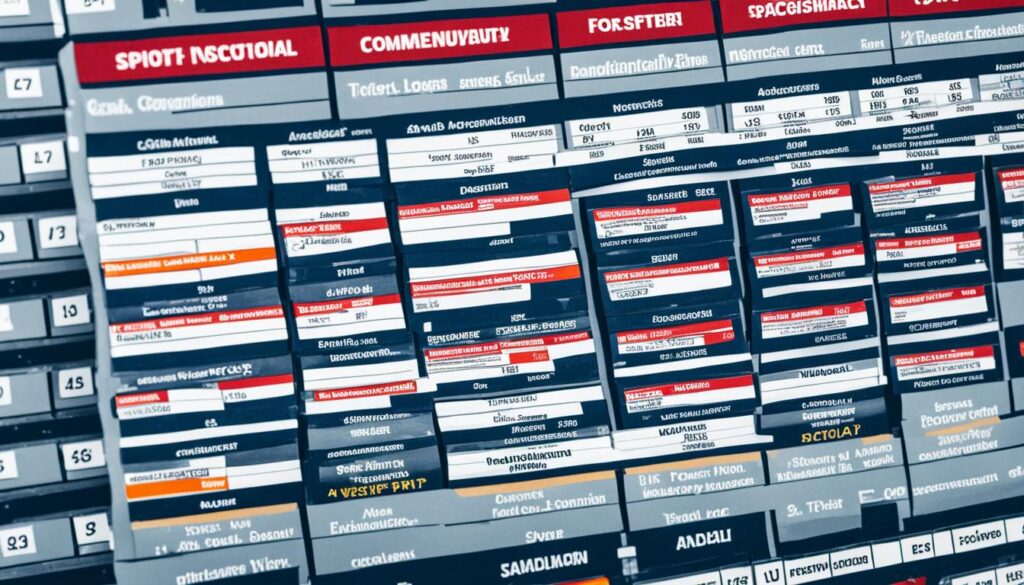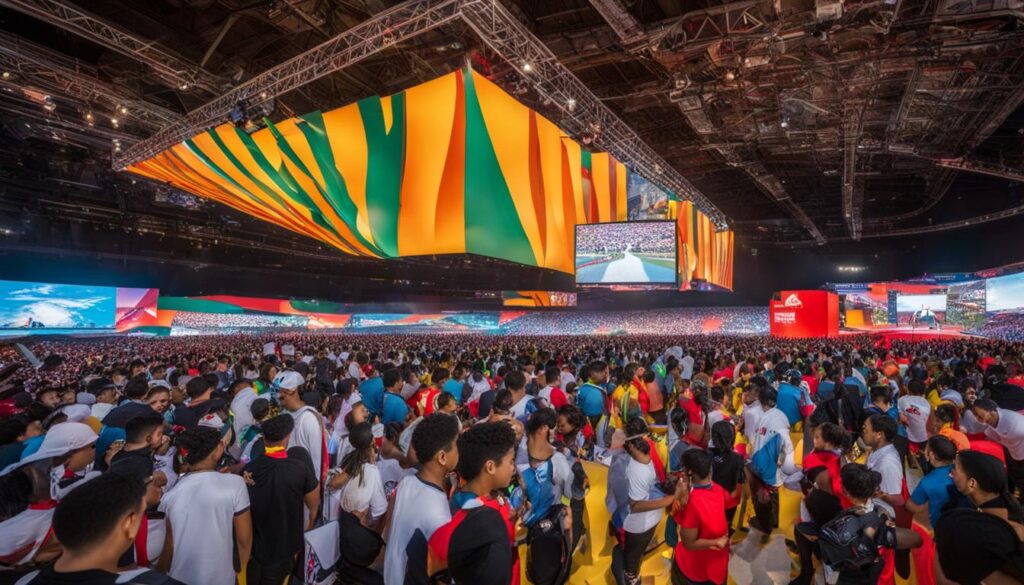As a media planner and buyer, understanding ad inventory is essential for maximizing the effectiveness of sports marketing campaigns. Ad inventory refers to the available space for ads and the management of media space in various sports platforms. Whether it’s TV visible signage in professional sports or out-of-home advertising strategies, navigating ad inventory strategically can help brands optimize their reach and make the most of their advertising efforts.
In sports media planning, ad inventory management plays a crucial role in determining the media space available for advertising placements. It involves keeping track of the available ad space, organizing inventory based on sports events and venues, and ensuring efficient utilization of media resources. By effectively managing ad inventory, media planners can ensure that brands have access to the right media platforms and placements that align with their target audience and campaign goals.
With the advent of technology and the impact of COVID-19 on in-venue advertising, virtual assets and branded tarps have become valuable additions to the traditional ad inventory in sports. These virtual assets provide an opportunity for brands to virtually place their ads in stadiums and arenas, reaching both the in-person audience and those tuning in from home.
To navigate ad inventory effectively, media planners need to have a comprehensive understanding of the different types of ad inventory available in professional sports. For example, in basketball, the NBA offers courtside rotational signage, while in baseball, MLB provides home plate rotational signage. In ice hockey, NHL dasherboards are highly visible, and in football, NFL LED signage dominates the stadiums. Similarly, MLS features LED field board signage. By identifying the types of ad inventory that resonate with their target audience, media planners can maximize their sports marketing efforts and ensure that their ads receive the visibility they deserve.
Are you ready to explore the world of ad inventory and media planning in the sports industry? Join me as we delve deeper into the different types of ad inventory, the role of out-of-home advertising in sports betting strategies, the importance of media buying, and the impact of programmatic advertising in this exciting and dynamic field.
Key Takeaways:
- Ad inventory determines the available space for ads and requires strategic management in sports media planning.
- Virtual assets and branded tarps have become valuable additions to traditional ad inventory in sports.
- Different sports offer varying types of ad inventory, such as NBA courtside rotational signage and NFL LED signage.
- Out-of-home advertising provides targeted reach and contextual relevance in sports betting strategies.
- Media buying plays a crucial role in selecting the right ad placements to reach the target audience.
TV Visible Signage: A Coveted In-Venue Advertising Asset
TV visible signage, also known as field level signage, is one of the most coveted in-venue advertising assets due to its prominent placement. It offers highly visible real estate for both fans in attendance and those watching from home. Different professional sports leagues have their variations of TV visible signage, such as NBA courtside rotational signage, MLB home plate rotational signage, NHL dasherboards, NFL LED signage, and MLS LED field board signage. These placements provide significant exposure during game action and TV broadcasts, making them valuable for brands looking to reach a wide audience in both the venue and at home.
| Professional Sports League | TV Visible Signage |
|---|---|
| NBA | Courtside Rotational Signage |
| MLB | Home Plate Rotational Signage |
| NHL | Dasherboards |
| NFL | LED Signage |
| MLS | LED Field Board Signage |
Benefits of TV Visible Signage:
- Highly visible during game action and TV broadcasts
- Targets both in-venue and remote audiences
- Promotes brand visibility and recognition
- Maximizes reach and exposure among sports fans
- Offers a prime advertising opportunity alongside the action
Leveraging Out-of-Home Advertising in Sports Betting Media Strategies
In the rapidly growing sports betting industry, brands and advertisers face fierce competition in capturing the attention of sports and gaming enthusiasts. To stand out in this crowded space, out-of-home (OOH) advertising offers unique advantages in maximizing reach and budgets for major sporting events and beyond.
One of the key advantages of OOH advertising is its ability to provide extensive impressions and high visibility. By strategically placing ads in sports-related venues and locations, brands can reach a large and targeted audience. Whether it’s billboards near stadiums or digital screens at sports bars, OOH advertising ensures contextual relevance and grabs the attention of sports fans.
Additionally, OOH advertising allows for hyper-localized content and real-time updates, making the ad experience more interactive and engaging. For example, brands can create dynamic ads that display live game scores or updates about ongoing sporting events. This real-time integration enhances audience connection and drives higher engagement rates.
Moreover, OOH advertising offers seamless digital integration with features like QR codes and retargeting capabilities. By incorporating QR codes into their ads, brands can drive online engagement by directing viewers to specific landing pages or promotions. Retargeting allows advertisers to display relevant ads to users who have interacted with their OOH ads, creating a cohesive and personalized advertising experience.
Overall, OOH advertising is a powerful tool for sports betting brands to create awareness and generate action among their target audience. Its advantages in maximizing reach and budgets, providing contextual relevance, offering interactive placements, and enabling digital integration make it a valuable component of sports betting media strategies.
The Importance of Media Buying in Advertising Campaigns
Media buying is a critical component of successful advertising campaigns, as it involves strategically selecting the right placements to effectively reach the target audience. Through media buying, advertisers purchase advertising space across various channels, including both traditional and digital media platforms.
In traditional media, such as television, radio, and print media, media buying focuses on securing optimal advertising placements to capture the attention of the target audience. This includes prime time TV slots, popular radio programs, and prominent print publications.
In the digital realm, media buying extends to websites, social media platforms, and mobile apps. Advertisers collaborate with media agencies to identify platforms and placements that align with their target audience’s online behavior and preferences. This enables brands to deliver their messages to the right people, at the right time, and in the right context.
Working closely with media agencies, advertisers develop strategic media plans that outline the desired target audience, advertising placements, and budget considerations. These plans guide the media buying process, ensuring that advertising space is secured in the most efficient and effective manner.
Traditional Media Buying
Traditional media buying involves negotiating with media outlets, such as TV networks, radio stations, and print publications, to secure ad placements. Advertisers leverage their relationship with media agencies to negotiate favorable rates and placements that align with their campaign goals and target audience.
Media agencies have a deep understanding of the traditional media landscape and can provide valuable insights on the most effective channels and placements for reaching the desired audience. They leverage their expertise to optimize media schedules and maximize the impact of advertising campaigns.
Digital Media Buying
Digital media buying encompasses a wide range of platforms and ad formats. Advertisers can utilize programmatic advertising, which uses advanced algorithms and real-time bidding to automate the media buying process and deliver highly targeted ads to the intended audience.
Programmatic advertising offers precise targeting capabilities, allowing advertisers to reach their target audience based on demographic data, interests, online behavior, and other parameters. This enables brands to deliver personalized and relevant messages to their target audience, increasing the effectiveness of their advertising campaigns.
Measurement and optimization are key components of digital media buying. Advertisers can track the performance of their ads, measure key metrics such as impressions, clicks, conversions, and ROI, and optimize their campaigns based on the insights gained. This data-driven approach enables advertisers to make informed decisions and continuously improve the effectiveness of their media buying strategies.
The Role of Media Agencies in Media Buying
Media agencies play a crucial role in the media buying process. With their expertise and industry knowledge, they assist advertisers in developing effective media plans, negotiating favorable rates and placements, and ensuring the seamless execution of advertising campaigns.
Media agencies have access to comprehensive data and insights on audience behavior, media consumption patterns, and industry trends. This information allows them to identify the most relevant and impactful advertising placements for reaching the target audience. They also stay updated on the latest media buying trends and technologies, enabling advertisers to leverage innovative approaches and stay ahead of the competition.
In summary, media buying is essential for advertisers looking to effectively reach their target audience. By strategically selecting the right advertising placements across both traditional and digital media channels, brands can optimize their campaigns, maximize their reach, and drive positive results.
Comparison of Traditional and Digital Media Buying
| Aspect | Traditional Media Buying | Digital Media Buying |
|---|---|---|
| Targeting | Demographic and contextual targeting | Precise targeting based on various parameters |
| Ad Formats | TV, radio, print | Display ads, video ads, native ads, social media ads |
| Media Planning | Seasonal campaigns, upfront negotiations | Continuous optimization and real-time bidding |
| Measurement and Optimization | Post-campaign analysis, limited real-time optimization | Real-time performance tracking, data-driven optimization |
| Flexibility | Limited flexibility in adjusting campaigns once launched | Highly flexible, allowing real-time adjustments and optimization |
The Role of Programmatic Advertising in Media Buying
Programmatic advertising has emerged as a powerful tool for advertisers, leveraging machine learning algorithms to deliver targeted advertising messages. This automated approach streamlines the ad buying process and enables brands to reach their desired audience across various channels. By harnessing the potential of programmatic advertising, advertisers can optimize their ad buying strategies and increase the efficiency of their campaigns.
One of the key components of programmatic advertising is the use of demand-side platforms (DSPs). These platforms provide advertisers with easy access to a wide range of advertising inventory at fixed prices. Advertisers can efficiently manage and acquire ad space through DSPs, ensuring the best placements for their campaigns.
Additionally, real-time bidding (RTB) plays a crucial role in programmatic media buying. Through RTB, advertisers participate in auctions to acquire ad opportunities in real-time. This dynamic bidding process allows brands to maximize their ad exposure and target specific audiences precisely when they are most receptive to advertising messages.
Efficiency is another significant advantage of programmatic advertising. By automating the ad buying process, advertisers can save time and resources while still ensuring optimized ad placements. Programmatic algorithms analyze vast amounts of data, enabling brands to make data-driven decisions in real-time and allocate their budgets more effectively.
Brand safety is a top priority in programmatic advertising. Advertisers can implement strict criteria and filters to ensure that their ads appear within brand-safe environments. This protects brands from potential negative associations and maximizes the impact of their advertising messages.
Moreover, programmatic advertising allows for seamless multi-channel integration. Advertisers can craft consistent messaging across multiple platforms, ensuring a cohesive brand experience for consumers. Whether it’s display ads, video ads, or native advertising, programmatic advertising enables brands to deliver their messages effectively through various channels.
The Benefits of Programmatic Advertising in Media Buying:
- Efficient ad buying process
- Targeted advertising messages
- Real-time bidding for optimized ad placements
- Brand safety through strict criteria and filters
- Seamless multi-channel integration
| Benefits of Programmatic Advertising | |
|---|---|
| Efficient ad buying process | Programmatic advertising automates the ad buying process, saving time and resources. |
| Targeted advertising messages | Machine learning algorithms enable precise targeting, reaching the right audience at the right time. |
| Real-time bidding for optimized ad placements | Real-time bidding allows advertisers to secure ad opportunities at the most opportune moments. |
| Brand safety through strict criteria and filters | Advertisers can implement brand safety measures to ensure their ads appear in suitable environments. |
| Seamless multi-channel integration | Programmatic advertising enables consistent messaging across various channels, enhancing brand consistency. |
Conclusion
Maximizing ad inventory is crucial for successful sports media planning and optimizing the effectiveness of sports marketing campaigns. By understanding the different types of ad inventory, such as TV visible signage in professional sports, brands can strategically utilize the available space for ads and maximize their media space efficiency.
Leveraging out-of-home advertising in sports betting strategies provides brands with targeted reach, contextual relevance, and real-time updates, enhancing the impact of their campaigns. Media buying plays a critical role in selecting the right advertising placements, ensuring that brands reach their target audience effectively.
Programmatic advertising offers efficient and targeted ad buying capabilities, allowing brands to optimize their media space and reach the right audience at the right time. By integrating these strategies, brands can drive successful advertising campaigns in the competitive sports industry and achieve their marketing objectives.
FAQ
What is ad inventory in sports media planning?
Ad inventory refers to the available space for ads and the effective management of media space in sports media planning. It plays a crucial role in determining the placement and availability of ad space for brands.
How does TV visible signage contribute to in-venue advertising?
TV visible signage, also known as field level signage, is a highly coveted in-venue advertising asset in professional sports. It offers prominent placement and visibility for brands, both in the venue and during TV broadcasts.
Which professional sports leagues have variations of TV visible signage?
Different professional sports leagues have their variations of TV visible signage, including NBA courtside rotational signage, MLB home plate rotational signage, NHL dasherboards, NFL LED signage, and MLS LED field board signage.
What advantages does out-of-home (OOH) advertising offer in sports betting media strategies?
Out-of-home advertising allows for maximizing reach and budgets in major sporting events and beyond. It provides extensive impressions, high visibility, and contextual relevance by targeting sports-related venues and locations.
How can programmatic advertising optimize media buying in advertising campaigns?
Programmatic advertising uses machine learning algorithms to deliver targeted advertising messages. It automates the ad buying process and enables multi-channel integration, efficient ad buying, and optimization, ensuring brand safety and maximized reach.
How does media buying contribute to advertising campaigns?
Media buying involves selecting the right advertising placements to effectively reach the target audience. It encompasses purchasing advertising space in various traditional and digital media channels and is essential for strategic campaign implementation and optimization.
What role does programmatic advertising play in media buying?
Programmatic advertising facilitates efficient and targeted ad buying. It uses demand-side platforms (DSPs) for fixed-price acquisitions or real-time bidding (RTB) in ad auctions. Programmatic advertising ensures brand safety, multi-channel integration, and optimized ad buying.
Source Links
- https://www.castiron.media/blog/then-now-navigating-the-in-venue-advertising-landscape-in-sports/
- https://broadsign.com/blog/a-sure-bet-maximizing-your-sports-betting-marketing-strategy-with-out-of-home-advertising/
- https://www.fusify.io/en/blog-en/where-and-how-to-place-advertising-what-is-media-buying-and-who-does-it

We at SportsBizTrends.com give you free sports business and marketing trends through written articles and a popular newsletter. Get fresh insights and ideas from around the world. We scout and compile, you read and act.









